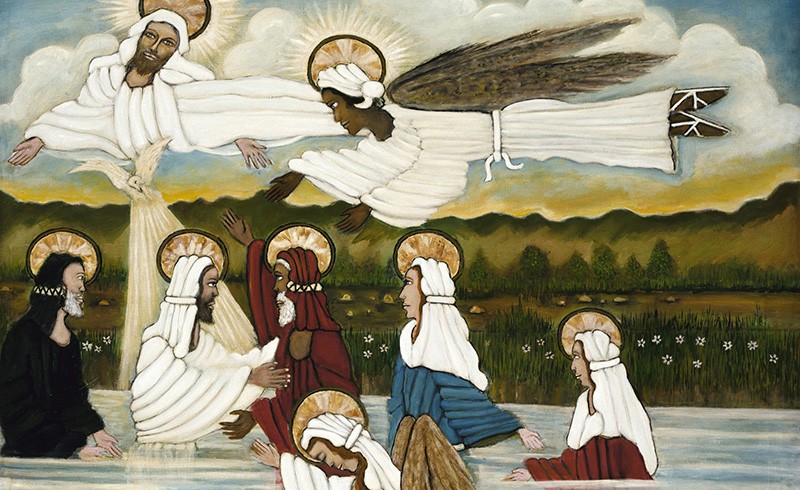Numbers are hardly inspiring, but they are indicative. A batting average of .350 is far more impressive than a batting average of .225. A shooting percentage in basketball of 50%, rather than 30%, can be the difference between advancing to the championship game and taking a long ride home. And most readers know the difference between a 95% and a 65% on an exam. By the numbers, pneuma features much more prominently in the letters of Paul than the Gospels.
Yet numbers do not tell the whole story. The Holy Spirit, grasped from the vantage point of the Gospels, is uncommon, astonishing, unconventional even, because the Spirit becomes enmeshed in the tortured — literally, tortured — life of Jesus of Nazareth. The Spirit is part of a lifelong drama, consisting of conflicts whose flames Jesus fans.

Jack Levison
As they remember his story, the authors of the four Gospels recollect that the uncommon presence of the Holy Spirit spanned Jesus’s life. The Spirit is, in a real sense, the tensive presence that holds together their narratives. Before Jesus even takes a step, some recall that the Holy Spirit inspired Elizabeth, Mary, Zechariah and John the Baptist (still in Elizabeth’s belly) to pray or praise or find themselves — Mary, at least — pregnant. They remember the descent of the Holy Spirit at Jesus’s baptism, the force of the Holy Spirit in the wilderness, Jesus’s dire warning about blasphemy against the Holy Spirit, his assurance of the Holy Spirit for martyrs, and even the promise of the Holy Spirit after his death.
The four Gospels, of course, are not homogeneous. No one ironed out the creases in the story so that all four Gospels speak with one voice, but the presence of the Spirit with Jesus is decisive in all four Gospels. It is almost inconceivable, for example, to imagine Jesus’s life without the descent of the Holy Spirit at his baptism. So crucial, so critical was that moment for what was about to unfold that the descent of the dove is one of those rare scenes that appear in all four Gospels.
The impact of the Holy Spirit on Jesus is pivotal to all four Gospels, and recognizing that the life of Jesus gives the Holy Spirit a unique tenor that occurs nowhere else in the annals of early Christian literature is just as essential.
The impact of Jesus’s story on the portrayal of the Holy Spirit in the Gospels is dramatic: there is just one moment in the whole of Jesus’s life when he rejoices in the Holy Spirit, and this in only one of the Gospels (Luke 10:21). One moment of joy. One glimpse of gladness.
“Jesus understands the Holy Spirit in terms other than joy and gladness.”
When the Holy Spirit is taken up in the currents that would lead to Jesus’s death, a certain grimness, a foreboding emerges. Jesus never engenders a naive hope of tranquility. Determined rather to ensure the fidelity of his followers after his death, Jesus understands the Holy Spirit in terms other than joy and gladness. Faithfulness to the point of death, yes. Reliability, to be sure. An exacting imitation of Jesus, absolutely. These are a few of the unmistakable marks of the Holy Spirit in the Gospels.
The Gospels offer what is not presented elsewhere in the New Testament, where the fruits of the Holy Spirit are love, joy, peace, patience, kindness, generosity, faithfulness, gentleness and self-control (Galatians 5:22–23) and where the gifts of the Spirit are an utterance of wisdom, an utterance of knowledge, faith, healing, miracles, prophecy, the discernment of spirits, various kinds of tongues and the interpretation of tongues (1 Corinthians 12:8–10).
There is, of course, some overlap between the letters of Paul and the stories of Jesus. For instance, there is the inspiration of a message focused on the cross (1 Corinthians 2:1–5). There is the association of joy with the Holy Spirit in the Pauline Letters (Romans 14:17; 15:13; Galatians 5:22; 1 Thessalonians 1:6) and words that express joy early in Luke’s Gospel (Luke 1:41, 67), as well as Jesus’s single instance of rejoicing in the Spirit (Luke 10:21). There is also a connection between the Holy Spirit and healing (1 Corinthians 12:9), as in the Gospels and Acts (Matthew 12:9–21; Acts 10:37–38).
“The Holy Spirit shows up in the oddest situations and the most baffling teachings of Jesus.”
Yet those who remembered the impact of the Holy Spirit on Jesus did not transform the Spirit wholesale into a source of abiding joy and peace and patience and kindness or anything that resembles speaking in tongues. Nor could they, bound as they were by the memory of Jesus — a memory that gave the Holy Spirit a dimmer tenor, a darker hue, overshadowed as it was by the long obedience of Jesus.
Refracted through the prism of Jesus’s life and death, therefore, the Holy Spirit shows up in the oddest situations and the most baffling teachings of Jesus — in desert sojourns, in a strange saying about scorpions and snakes, in puzzling adages about birth from above and springs from below. The Gospels disclose an alien world of the Spirit, a world that mystifies, challenges and invigorates. This is the unconventional yet ultimately inspiring world of the Holy Spirit — the Spirit of the Gospels.
 Excerpted from An Unconventional God by Jack Levison, ©2020. Used by permission of Baker Publishing www.bakerpublishinggroup.com. Jack Levison holds the W.J.A. Power Chair of Old Testament Interpretation and Biblical Hebrew at Perkins School of Theology at Southern Methodist University. He is known for his groundbreaking work on the Holy Spirit and topics both biblical and theological.
Excerpted from An Unconventional God by Jack Levison, ©2020. Used by permission of Baker Publishing www.bakerpublishinggroup.com. Jack Levison holds the W.J.A. Power Chair of Old Testament Interpretation and Biblical Hebrew at Perkins School of Theology at Southern Methodist University. He is known for his groundbreaking work on the Holy Spirit and topics both biblical and theological.
More by Jack Levison:


